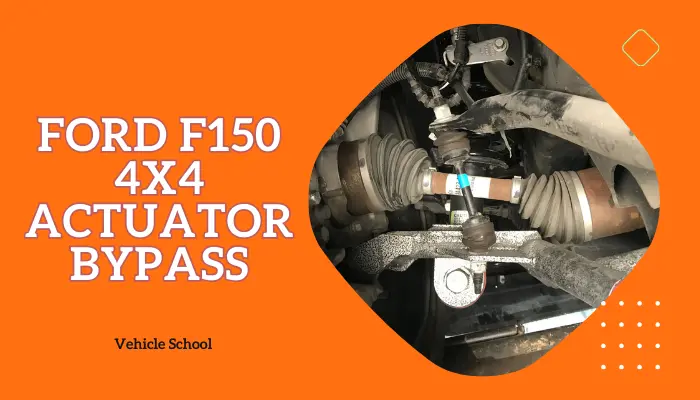Trying to figure out where to add the transmission fluid in a Ford F150? Maybe you’ve noticed some shifting issues or just want to stay on top of maintenance.
No worries though, I’ll help you out, Keep reading to learn what to do with both the f150 automatic 6-speed transmission and the 10-speed one.
Ford F-150 Transmission Fluid Change Step-By-Step Process
Here’s the full process of changing the transmission fluid in Ford F150 10R80 transmission:
- Disconnect the negative battery cable.
- Raise and secure the truck.
- Remove transmission cooler lines and cooler assembly.
- For 5.0L F-150 models, unbolt the transmission mount and exhaust hanger, and lift the transmission slightly.
- Remove transmission pan bolts and drain fluid.
- Replace the old transmission filter with a new one.
- Clean pan and transmission mating surface.
- Install a new pan gasket and reinstall the pan, tightening bolts in a crisscross pattern to the specified torque.
- Reinstall transmission cooler lines and assembly.
- Fill transmission with correct Mercon ULV fluid through the fill port.
- Start the engine, cycle through gear ranges, and check/adjust the fluid level.
- Double-check for leaks and secure all components.
FordTechMakuloco has a full demonstration of the process;
Here’s how to change the transmission fluid of the Ford F150 6R80 transmission:
- Gather these gears: fluid, pan, wrench set, torque wrench, foil, cleaner, filter, gasket. Consider using a fluid extractor for easier handling.
- Find fill plug: large bolt, passenger side, front, socket wrench.
- Remove bolts from the pan back, and use foil to direct fluid into the drain pan.
- Remove all pan bolts, clean the pan and transmission surface, drain and replace the fluid in 4-quart increments.
- Replace the old filter, install new one and gasket securely.
- Reattach the pan and tighten the bolts with a torque wrench.
- Refill transmission with fresh fluid, monitor and adjust level.
- Start the engine, shift through gears, cool, and check the fluid level.
- Ensure tightness, clean up and dispose of old fluid properly.
Here’s a video demonstration of the process:
| Note: F150s usually take about 7-8 quarts if you do everything including pan drop and filter change. You’ll be best off checking your owner’s manual for the exact capacity – which can change based on model and year. |
Changing the transmission fluid of Ford F150’s manual transmissions (M50D-R2) is much simpler.
The process is for the M50D-R2, which is common in many 1988–2008 F150s. I’ll just provide a gist of it here.
You’ll simply need to lift your truck, remove the fill plug and drain plugs, drain the fluid, refill with ATF until it overflows, and tighten the fill plug.
How To Check Transmission Fluid In F150?
Here’s how to check the transmission fluid level in your Ford F150:
- Locate the dipstick in your vehicle’s engine bay, by the back of said engine.
- Remove the dipstick while the engine is running and the parking brake is engaged.
- Inspect the color and consistency of the transmission fluid on the dipstick.
- Clean the dipstick with a lint-free rag and reinsert it into the transmission.
- Do a fluid level check on the dipstick to ensure it reaches the “full” or “max” line.
- If necessary, use a funnel to refill the transmission fluid, being cautious not to overfill.
How Much Does Ford F-150 Transmission Fluid Change Cost?
Changing the transmission fluid in an F-150 usually costs between $150 to $250, including the flush cost, with dealerships sometimes charging more, say around $260 for a full flush.
When Is It Required To Change Transmission Fluid in Ford F-150?
According to the official Ford Service Page, it’s recommended to change the transmission fluid in Ford F-150 after every 150,000 miles or 240,000 km, which is usually every few years.
However, most transmission specialists, experienced users from forums, and even official Ford Dealerships suggest changing the fluid every 30–60k miles to prevent ford transmission problems, potentially saving on costly repairs down the line.
With certain older transmissions, though, things can go wrong and you might be looking to do that early.
What Type of Transmission Fluid Does Ford Recommend For F150?
The 2024 F-150 needs Motorcraft® MERCON® ULV Automatic Transmission Fluid, XT-12-QULV is the best transmission fluid for a Ford F150, according to the owner’s manual. If you’ve got a different year, you can look up this FCSD Chemicals and Lubricants Quick Reference Chart.
Do I Recommend To Flush The Transmission Or Drain And Fill It?
If your transmission is working fine, going for a drain and refill instead of a transmission fluid flush is a safer bet. Flushing it out unnecessarily can stir up debris or dislodge gunk that’s been sitting around, potentially causing problems down the road.
What Are The Signs Of Low Transmission Fluid?
Your Ford needs enough transmission fluid to work properly. Here are some signs that show if the transmission fluid is low in an F150:
- You’ll notice your ford f150 gear shift not working properly or gears slipping in your truck.
- You’ll feel a bit of a bump when you change gears.
- You can feel a delayed response when shifting into drive or reverse.
- Your truck’s gears may not shift at all.
- Your truck will get too hot for no obvious reason.
FAQs
Is it bad to drive with low transmission fluid?
Let me put it this way: whether you’re using an automatic or manual transmission, you NEVER want to have low fluid. You might hear weird noises, your truck could get too hot, and shifting gears might become difficult. That’s not the worst part either; even if you can drive for a bit with low fluid, it’s risky because your transmission could break completely, and that’s expensive to fix.
Does Ford recommend changing the transmission filter?
There’s no direct comment from Ford. Still, many Ford dealerships, like McDavid Ford, suggest doing this with any Ford Transmission. As an extra side note, the 6r80 transmission filter change is the easiest process, even compared to the new 10-speed transmissions.
Ending Remarks
Transmissions are a pain to deal with when it comes to DIY, so you’ll be lucky if the most you need to do is a fluid change, even after a long time.
Replacing the whole transmission takes a lot more effort.
Anyway, that should get your transmission topped up, do remember to generally drive it carefully. After all, that’s a big part of the whole drive system.






